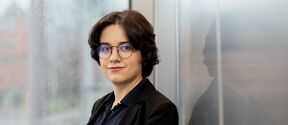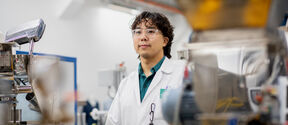The ice whisperers

Emperor penguins are a curious bunch.
As Jukka Tuhkuri, an ice scientist and professor at Aalto University, drilled into the ice on the Weddell Sea, a group of the metre-tall birds calmly observed what he and the other scientists were up to.

Adjacent to Antarctica, the Wendell Sea is about as big as all the Nordic countries combined. In early 2022, Tuhkuri spent seven weeks aboard the research vessel S.A. Agulhas II as a member of the 65-person international expedition Endurance22. Most of those on the voyage were tasked with searching for the wreck of the Endurance, Ernest Shackleton’s ship that famously sank in 1915, but 15 ice scientists had also joined the team.
As a robotic submersible scanned the sea floor three kilometres down, a crane dropped the scientists onto the surface of the ice to gather samples and take measurements.
Tuhkuri’s tool of choice was an ice auger, a 120-centimetre-long tube that can drill up to three metres into ice with the help of extra handles. He could use it to measure the temperature, density and salinity of the ice. Why? These properties determine the strength of ice and how it breaks when colliding with a ship, a bridge or a wind farm at sea.
The temperature throughout the ice core was about –1.8 degrees Celsius, the same as the freezing point of seawater. ‘Very, very warm,’ says Tuhkuri, whose research group specialises in the fracture mechanics of ice.
Missing pancakes
Normally around Antarctica, at the outer edge of the sea ice, there are small ice floes rounded by the waves – a type of ice called pancake ice. ‘There were no proper waves or pancake ice on this trip,’ Tuhkuri says with regret.
To an ice scientist, ice is never just ice – it’s a complex and enormously variable material. Glacier ice, made of compacted snow, is completely different in crystal structure from floating ice made of frozen water. Saltier ice is more porous than ice made of fresh water and, as a result, weaker.

In Otaniemi, Jukka Tuhkuri and colleagues study ice at Aalto’s two ice tanks. The Aalto Ice and Wave tank measures 40 by 40 metres and is 2.8 metres deep, making it the world’s largest indoor ice tank by area. In its icy waters, scientists can test ships and other marine structures, and Tuhkuri and colleagues use it to closely study the properties of ice and how it breaks.
The water in the tank isn’t salty like sea water, but more like regular tap water with a bit of ethanol. ‘We would need several trucks full of salt to mimic the saltwater of the oceans, and it would corrode more or less everything in the tank,’ Tuhkuri explains.
For this reason, tests on sea ice are conducted in a smaller two-by-four metre tank in a well-isolated cold chamber shielded by a heavy specialised door. The tank and machinery needed to grow sea ice was designed and built by doctoral researcher Sid Oksala.


The crystal structure of the ice is revealed through thin cross-sections produced using a special plane or a router. Tuhkuri commonly drops the room’s temperature to –18 degrees C to cut the thin sections. Working with saline ice in warmer conditions is challenging, but any colder and things start falling out of scientists' hands – it’s just too chilly.
When floating ice develops naturally, it crystallises into columns that grow from the surface downwards. Each crystal is about the thickness of a finger and as long as the ice is deep.
The crystal columns in freshwater ice have clear boundaries and appear to be very similar to each other. In saltwater, the crystals are more irregular, making for a larger variety in any batch.
‘Saltwater’s impurities and air bubbles get inside the crystals,’ says Tuhkuri. ‘That’s why fresh and saltwater ice are so different.’
Rewriting the textbooks
At the beginning of the expedition, Tuhkuri put an automated camera system developed by doctoral researcher Andrei Sandru into the ship’s crow’s nest. It snapped pictures of the ice in front of the ship every five seconds in order to analyse the size of ice floes and the amount of ice cover – the ratio between open water and ice – with the help of computer vision. At the same time, sensors on the ship’s hull recorded the forces from ice impacts.

Unlike the rest of those onboard, Tuhkuri was hoping for high winds and waves so they’d be able to observe the combined effects of storms and ice.
There was no storm, but one morning Tuhkuri saw that a sensor had registered a whopping 775 kilonewtons of force overnight. That was just four kilonewtons shy of the load the ship’s hull had been designed to withstand – a little too close for comfort.
‘I rushed to the bridge to ask the captain what had happened overnight. He said, “Nothing,” and we couldn’t find an explanation in the photos either.’
The reason for the impact remained a mystery during the voyage, but now Tuhkuri thinks he knows what happened: in the early spring, ice thaws, becoming softer and messier. It’s called rotten ice in English and brittle ice in Tuhkuri’s native Finnish.

But the brittleness is an illusion, says Tuhkuri.
‘Force is the pressure times the area. When very cold, hard ice hits a ship, the pressure is large, but the contact area is small. With warm ice, the pressure is smaller, but the contact area is much larger, so the force may go up.’
The temperature of ice varies in nature, but in the lab, it’s been studied and modelled for decades at –10 degrees C. So scientists’ common understanding of ice is based on models that don’t always match the great outdoors.
In 2021, Tuhkuri’s group was the first in the world to demonstrate that warm and cold ice fracture differently.
Textbooks say that ice deforms in three different ways in response to a force. An elastic deformation means the ice recovers its shape immediately when the force is removed. A viscoelastic deformation increases with time if the force holds but also recovers with time when the load is removed. A plastic deformation is permanent.
When Tuhkuri and colleagues loaded ice at –0.3 degrees C, they didn’t see any viscoelastic deformation – only elastic and plastic.
What does that mean in practice? ‘We don’t know yet,’ says Tuhkuri. ‘That’s what we have to find out next. Textbooks and computational models need to be updated.’

The hot cold place
The trip to the Weddell Sea was a success: the Endurance22 expedition found Endurance, and Tuhkuri collected enough ice data to fill many hard drives. The emperor penguins even came to say goodbye on their last day on the ice before the expedition headed back home.
The trip holds a special place in Tuhkuri’s heart; after all, Shackleton was his childhood hero, and Jack London’s adventures were his favourite books. It’s no surprise that after high school Tuhkuri went to study shipbuilding.
But in his third year of studies, a note on a notice board changed his plans.
“There was an extra course on arctic technology for marine engineers. On the first day there was a presentation by professor Wilford Franks “Willy” Weeks, a pioneer in the field from the University of Alaska. He showed pictures of thin sections and talked about ice crystals, and that was it — I knew what I wanted to do.”

Thanks to new methods, studies of ice mechanics have progressed quickly during Tuhkuri’s career. The growth of cracks can be observed with digital image correlation methods developed by Professor Sven Bossuyt and postdoctoral researcher Waqas Ahmad. Professor Arttu Polojärvi uses simulations to study the effects of ice movement on offshore wind farms with world-class accuracy.
Experimental ice research that couldn’t be done anywhere else is possible in the Aalto Ice and Wave Tank. Visitors come from all around the world and there is collaboration in every direction, says Tuhkuri.
‘We’ve become a hot place – or at least a hot cold place. Climate change has made this research area even more critical.’
Jukka TuhkuriWe’ve become a hot place – or at least a hot cold place. Climate change has made this research area even more critical.
Changes in the material properties of ice are mirrored by the changes in Arctic ice conditions. There is normally a zone between pack ice and the open ocean where ice floes move with the waves. This zone is called the marginal ice zone. Now, the area of the pack ice is decreasing, and the marginal ice zones are expanding. Tuhkuri fears that ships that aren’t designed to withstand the loads from ice will venture into arctic waters.
‘We don’t know enough about the conditions in these marginal ice zones. But even Shackleton understood that it’s dangerous amid the ice and waves.’
What would Tuhkuri like everyone to understand about his work? ‘We’ve messed up, and the ice has already changed. Now we need to figure out what this means for the environment and for society. Studying and stopping climate change is important, but we also have to use science to find ways to adapt to the new conditions.’
Photographs taken during the Endurance22 Expedition are reproduced by kind permission of the Falklands Maritime Heritage Trust.
Other photos: Jukka Tuhkuri, Jaakko Kahilaniemi, Mikko Raskinen
Translation from Finnish: Amanda Alvarez
This article has been published in the Aalto University Magazine issue 34 (issuu.com), September 2024.
Read more news

Future makers research batteries, cryptography and plastic recycling
The Technology Industries of Finland Centennial Foundation awarded 3.5 million euros in research funding to eight projects, five from Aalto University.
The pilot project for direct article delivery from the National Repository Library ends
Aalto University has been participated in the pilot project for direct article delivery with the National Repository Library and Kopiosto from 2023 to 2025. The pilot ends on 19th December.
Meet the new ELLIS Institute PIs: Azade Farshad advances AI for medical applications
Farshad’s research background is in computer vision and generative models.






